Research: Hardcopy Books vs. eBooks - ICON College Student Choices
VerifiedAdded on 2024/05/14
|41
|9960
|215
Project
AI Summary
This research project investigates the preferences of ICON College students regarding hardcopy books versus eBooks, examining the impact of digitalization on reading and learning habits. It explores the shift from traditional to digital education, highlighting the role of modern technologies like phones, eBooks, and tablets. The study aims to analyze student choices, understand the effects of pricing on preferences, and evaluate the sufficiency of online libraries. Employing both primary and secondary research methods, the project reviews existing literature on the subject, discusses data collection and analysis techniques, and presents findings on the advantages and disadvantages of each format. Ultimately, the research seeks to provide insights into how digitalization influences educational practices and student learning experiences, comparing the use of hardcopy books and eBooks.
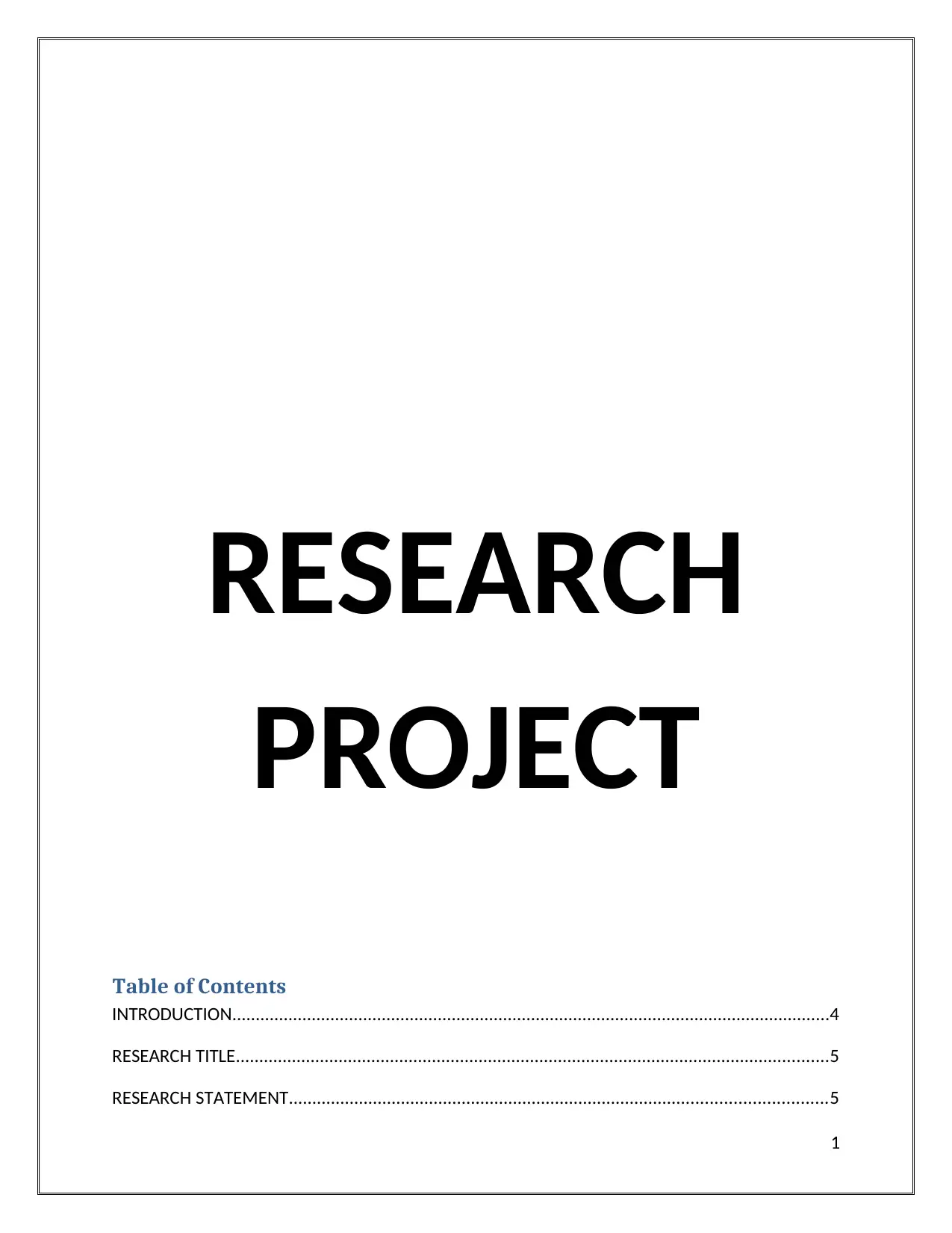
RESEARCH
PROJECT
Table of Contents
INTRODUCTION................................................................................................................................4
RESEARCH TITLE...............................................................................................................................5
RESEARCH STATEMENT...................................................................................................................5
1
PROJECT
Table of Contents
INTRODUCTION................................................................................................................................4
RESEARCH TITLE...............................................................................................................................5
RESEARCH STATEMENT...................................................................................................................5
1
Paraphrase This Document
Need a fresh take? Get an instant paraphrase of this document with our AI Paraphraser
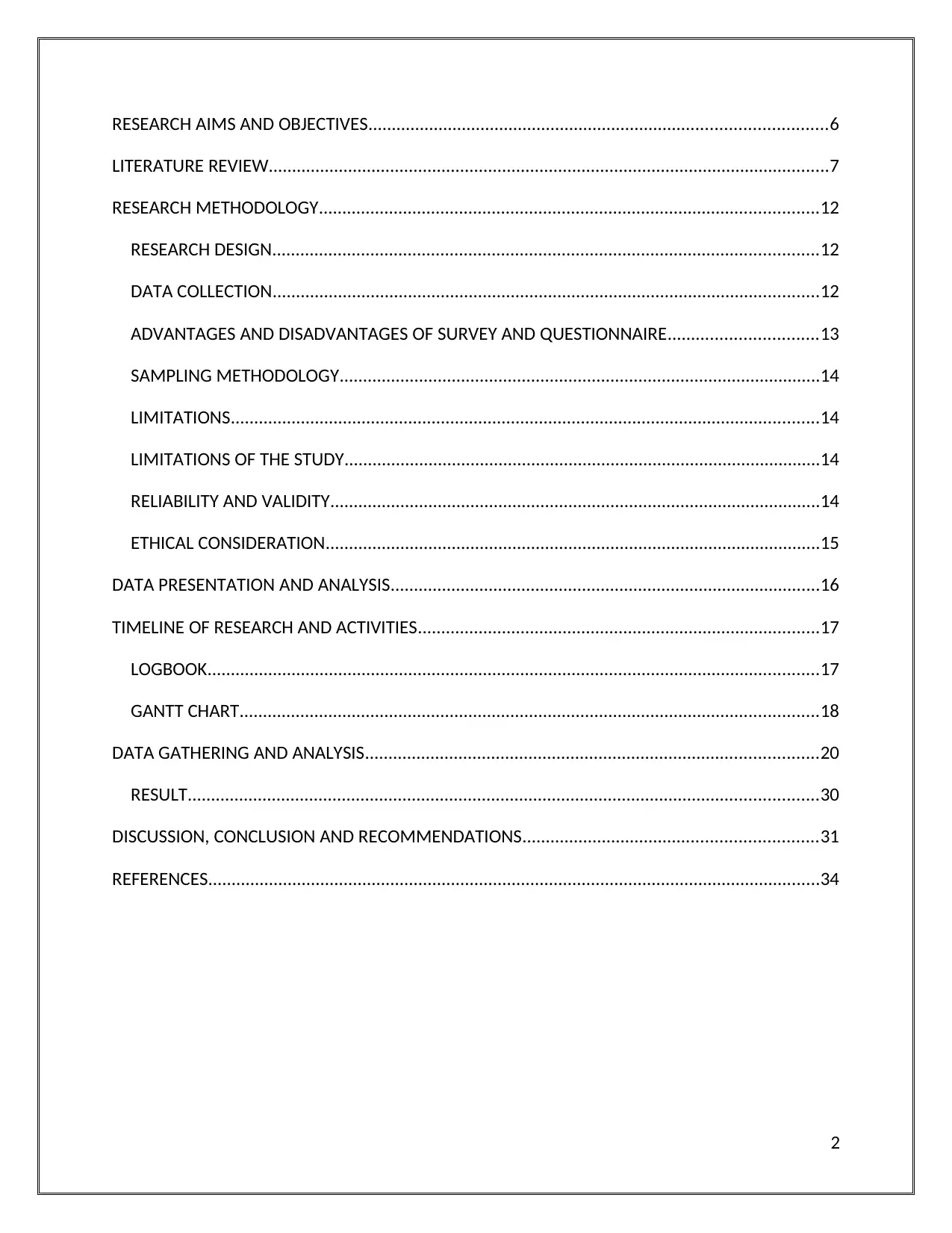
RESEARCH AIMS AND OBJECTIVES..................................................................................................6
LITERATURE REVIEW........................................................................................................................7
RESEARCH METHODOLOGY...........................................................................................................12
RESEARCH DESIGN.....................................................................................................................12
DATA COLLECTION.....................................................................................................................12
ADVANTAGES AND DISADVANTAGES OF SURVEY AND QUESTIONNAIRE................................13
SAMPLING METHODOLOGY.......................................................................................................14
LIMITATIONS..............................................................................................................................14
LIMITATIONS OF THE STUDY......................................................................................................14
RELIABILITY AND VALIDITY.........................................................................................................14
ETHICAL CONSIDERATION..........................................................................................................15
DATA PRESENTATION AND ANALYSIS............................................................................................16
TIMELINE OF RESEARCH AND ACTIVITIES......................................................................................17
LOGBOOK...................................................................................................................................17
GANTT CHART............................................................................................................................18
DATA GATHERING AND ANALYSIS.................................................................................................20
RESULT.......................................................................................................................................30
DISCUSSION, CONCLUSION AND RECOMMENDATIONS...............................................................31
REFERENCES...................................................................................................................................34
2
LITERATURE REVIEW........................................................................................................................7
RESEARCH METHODOLOGY...........................................................................................................12
RESEARCH DESIGN.....................................................................................................................12
DATA COLLECTION.....................................................................................................................12
ADVANTAGES AND DISADVANTAGES OF SURVEY AND QUESTIONNAIRE................................13
SAMPLING METHODOLOGY.......................................................................................................14
LIMITATIONS..............................................................................................................................14
LIMITATIONS OF THE STUDY......................................................................................................14
RELIABILITY AND VALIDITY.........................................................................................................14
ETHICAL CONSIDERATION..........................................................................................................15
DATA PRESENTATION AND ANALYSIS............................................................................................16
TIMELINE OF RESEARCH AND ACTIVITIES......................................................................................17
LOGBOOK...................................................................................................................................17
GANTT CHART............................................................................................................................18
DATA GATHERING AND ANALYSIS.................................................................................................20
RESULT.......................................................................................................................................30
DISCUSSION, CONCLUSION AND RECOMMENDATIONS...............................................................31
REFERENCES...................................................................................................................................34
2
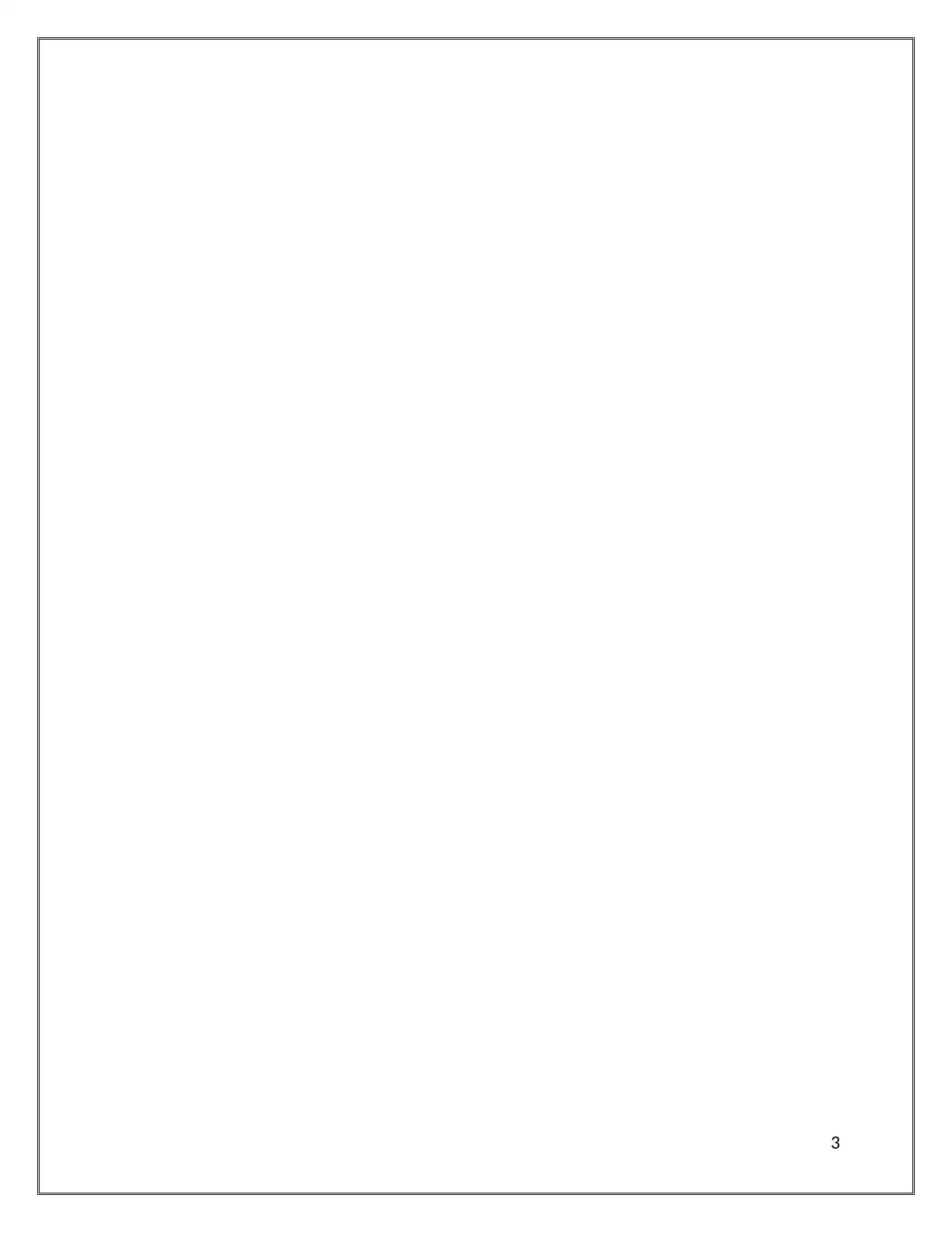
3
⊘ This is a preview!⊘
Do you want full access?
Subscribe today to unlock all pages.

Trusted by 1+ million students worldwide
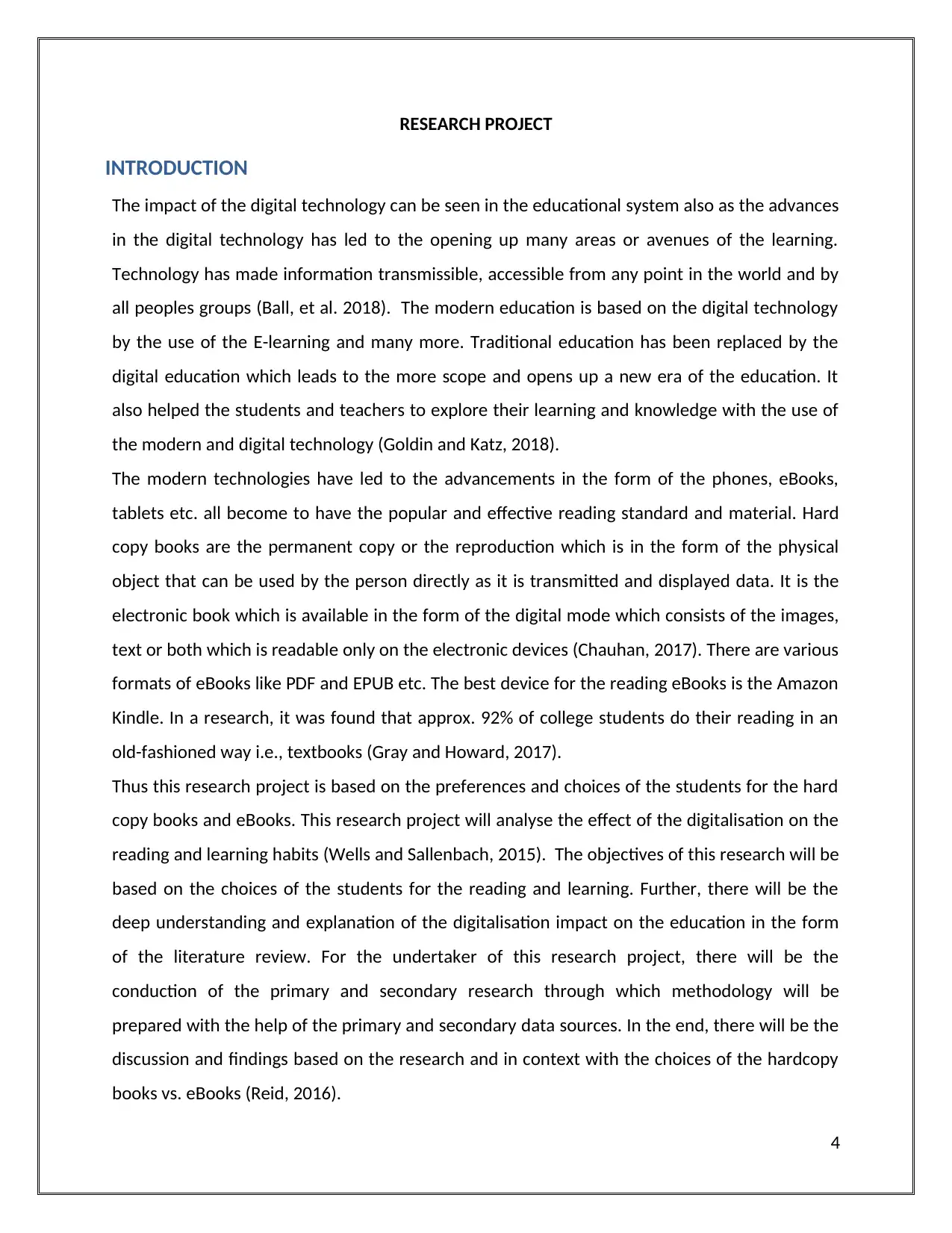
RESEARCH PROJECT
INTRODUCTION
The impact of the digital technology can be seen in the educational system also as the advances
in the digital technology has led to the opening up many areas or avenues of the learning.
Technology has made information transmissible, accessible from any point in the world and by
all peoples groups (Ball, et al. 2018). The modern education is based on the digital technology
by the use of the E-learning and many more. Traditional education has been replaced by the
digital education which leads to the more scope and opens up a new era of the education. It
also helped the students and teachers to explore their learning and knowledge with the use of
the modern and digital technology (Goldin and Katz, 2018).
The modern technologies have led to the advancements in the form of the phones, eBooks,
tablets etc. all become to have the popular and effective reading standard and material. Hard
copy books are the permanent copy or the reproduction which is in the form of the physical
object that can be used by the person directly as it is transmitted and displayed data. It is the
electronic book which is available in the form of the digital mode which consists of the images,
text or both which is readable only on the electronic devices (Chauhan, 2017). There are various
formats of eBooks like PDF and EPUB etc. The best device for the reading eBooks is the Amazon
Kindle. In a research, it was found that approx. 92% of college students do their reading in an
old-fashioned way i.e., textbooks (Gray and Howard, 2017).
Thus this research project is based on the preferences and choices of the students for the hard
copy books and eBooks. This research project will analyse the effect of the digitalisation on the
reading and learning habits (Wells and Sallenbach, 2015). The objectives of this research will be
based on the choices of the students for the reading and learning. Further, there will be the
deep understanding and explanation of the digitalisation impact on the education in the form
of the literature review. For the undertaker of this research project, there will be the
conduction of the primary and secondary research through which methodology will be
prepared with the help of the primary and secondary data sources. In the end, there will be the
discussion and findings based on the research and in context with the choices of the hardcopy
books vs. eBooks (Reid, 2016).
4
INTRODUCTION
The impact of the digital technology can be seen in the educational system also as the advances
in the digital technology has led to the opening up many areas or avenues of the learning.
Technology has made information transmissible, accessible from any point in the world and by
all peoples groups (Ball, et al. 2018). The modern education is based on the digital technology
by the use of the E-learning and many more. Traditional education has been replaced by the
digital education which leads to the more scope and opens up a new era of the education. It
also helped the students and teachers to explore their learning and knowledge with the use of
the modern and digital technology (Goldin and Katz, 2018).
The modern technologies have led to the advancements in the form of the phones, eBooks,
tablets etc. all become to have the popular and effective reading standard and material. Hard
copy books are the permanent copy or the reproduction which is in the form of the physical
object that can be used by the person directly as it is transmitted and displayed data. It is the
electronic book which is available in the form of the digital mode which consists of the images,
text or both which is readable only on the electronic devices (Chauhan, 2017). There are various
formats of eBooks like PDF and EPUB etc. The best device for the reading eBooks is the Amazon
Kindle. In a research, it was found that approx. 92% of college students do their reading in an
old-fashioned way i.e., textbooks (Gray and Howard, 2017).
Thus this research project is based on the preferences and choices of the students for the hard
copy books and eBooks. This research project will analyse the effect of the digitalisation on the
reading and learning habits (Wells and Sallenbach, 2015). The objectives of this research will be
based on the choices of the students for the reading and learning. Further, there will be the
deep understanding and explanation of the digitalisation impact on the education in the form
of the literature review. For the undertaker of this research project, there will be the
conduction of the primary and secondary research through which methodology will be
prepared with the help of the primary and secondary data sources. In the end, there will be the
discussion and findings based on the research and in context with the choices of the hardcopy
books vs. eBooks (Reid, 2016).
4
Paraphrase This Document
Need a fresh take? Get an instant paraphrase of this document with our AI Paraphraser
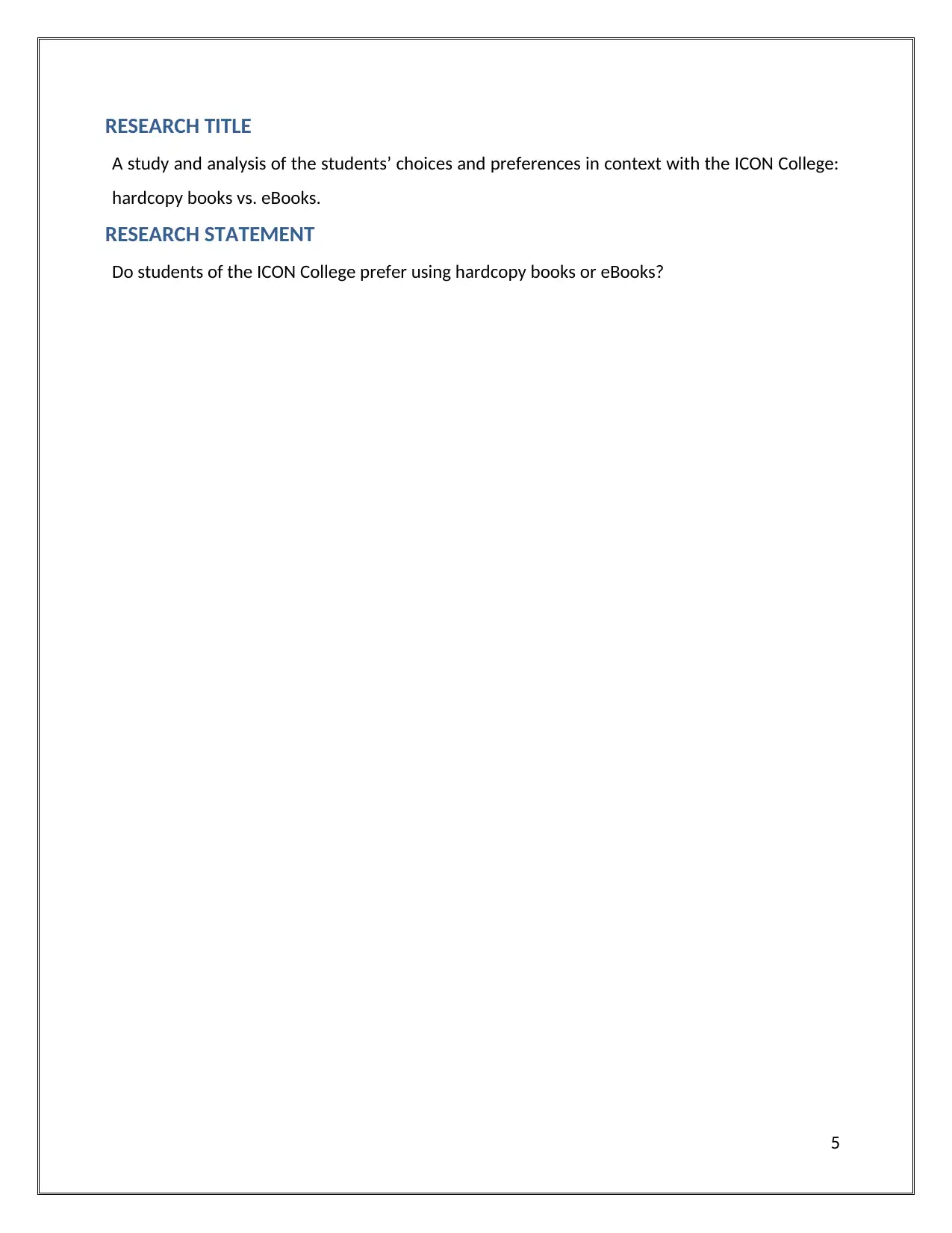
RESEARCH TITLE
A study and analysis of the students’ choices and preferences in context with the ICON College:
hardcopy books vs. eBooks.
RESEARCH STATEMENT
Do students of the ICON College prefer using hardcopy books or eBooks?
5
A study and analysis of the students’ choices and preferences in context with the ICON College:
hardcopy books vs. eBooks.
RESEARCH STATEMENT
Do students of the ICON College prefer using hardcopy books or eBooks?
5
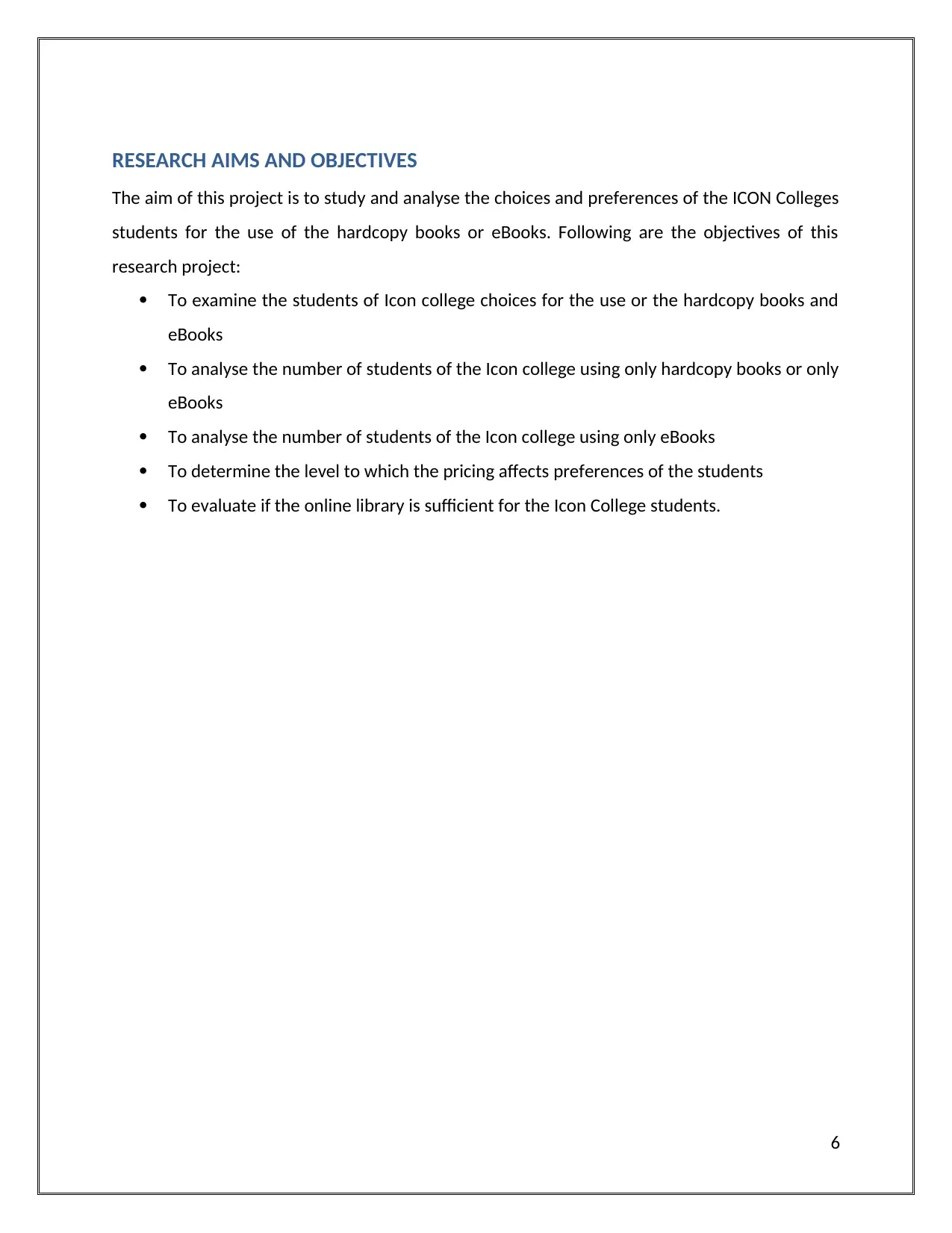
RESEARCH AIMS AND OBJECTIVES
The aim of this project is to study and analyse the choices and preferences of the ICON Colleges
students for the use of the hardcopy books or eBooks. Following are the objectives of this
research project:
To examine the students of Icon college choices for the use or the hardcopy books and
eBooks
To analyse the number of students of the Icon college using only hardcopy books or only
eBooks
To analyse the number of students of the Icon college using only eBooks
To determine the level to which the pricing affects preferences of the students
To evaluate if the online library is sufficient for the Icon College students.
6
The aim of this project is to study and analyse the choices and preferences of the ICON Colleges
students for the use of the hardcopy books or eBooks. Following are the objectives of this
research project:
To examine the students of Icon college choices for the use or the hardcopy books and
eBooks
To analyse the number of students of the Icon college using only hardcopy books or only
eBooks
To analyse the number of students of the Icon college using only eBooks
To determine the level to which the pricing affects preferences of the students
To evaluate if the online library is sufficient for the Icon College students.
6
⊘ This is a preview!⊘
Do you want full access?
Subscribe today to unlock all pages.

Trusted by 1+ million students worldwide
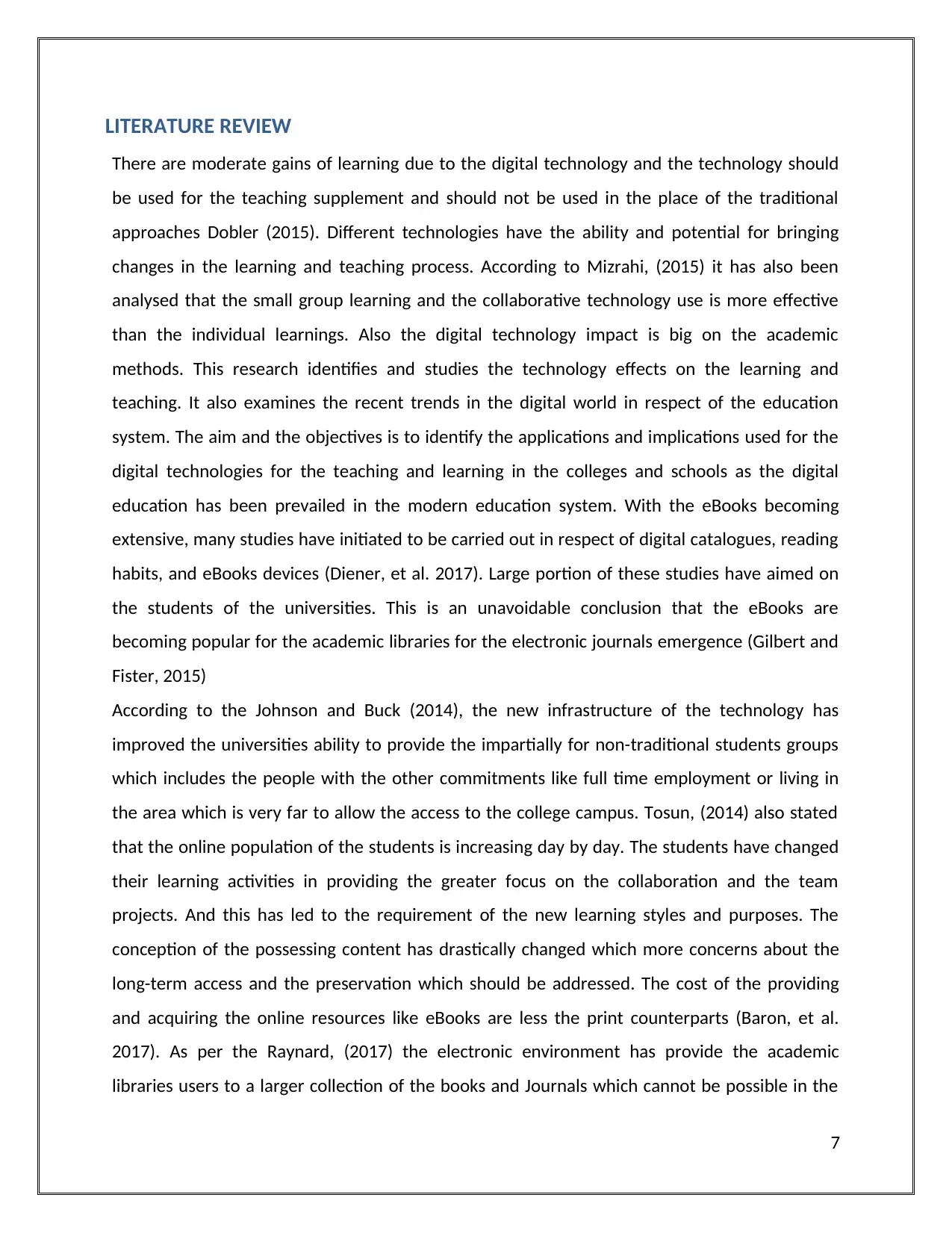
LITERATURE REVIEW
There are moderate gains of learning due to the digital technology and the technology should
be used for the teaching supplement and should not be used in the place of the traditional
approaches Dobler (2015). Different technologies have the ability and potential for bringing
changes in the learning and teaching process. According to Mizrahi, (2015) it has also been
analysed that the small group learning and the collaborative technology use is more effective
than the individual learnings. Also the digital technology impact is big on the academic
methods. This research identifies and studies the technology effects on the learning and
teaching. It also examines the recent trends in the digital world in respect of the education
system. The aim and the objectives is to identify the applications and implications used for the
digital technologies for the teaching and learning in the colleges and schools as the digital
education has been prevailed in the modern education system. With the eBooks becoming
extensive, many studies have initiated to be carried out in respect of digital catalogues, reading
habits, and eBooks devices (Diener, et al. 2017). Large portion of these studies have aimed on
the students of the universities. This is an unavoidable conclusion that the eBooks are
becoming popular for the academic libraries for the electronic journals emergence (Gilbert and
Fister, 2015)
According to the Johnson and Buck (2014), the new infrastructure of the technology has
improved the universities ability to provide the impartially for non-traditional students groups
which includes the people with the other commitments like full time employment or living in
the area which is very far to allow the access to the college campus. Tosun, (2014) also stated
that the online population of the students is increasing day by day. The students have changed
their learning activities in providing the greater focus on the collaboration and the team
projects. And this has led to the requirement of the new learning styles and purposes. The
conception of the possessing content has drastically changed which more concerns about the
long-term access and the preservation which should be addressed. The cost of the providing
and acquiring the online resources like eBooks are less the print counterparts (Baron, et al.
2017). As per the Raynard, (2017) the electronic environment has provide the academic
libraries users to a larger collection of the books and Journals which cannot be possible in the
7
There are moderate gains of learning due to the digital technology and the technology should
be used for the teaching supplement and should not be used in the place of the traditional
approaches Dobler (2015). Different technologies have the ability and potential for bringing
changes in the learning and teaching process. According to Mizrahi, (2015) it has also been
analysed that the small group learning and the collaborative technology use is more effective
than the individual learnings. Also the digital technology impact is big on the academic
methods. This research identifies and studies the technology effects on the learning and
teaching. It also examines the recent trends in the digital world in respect of the education
system. The aim and the objectives is to identify the applications and implications used for the
digital technologies for the teaching and learning in the colleges and schools as the digital
education has been prevailed in the modern education system. With the eBooks becoming
extensive, many studies have initiated to be carried out in respect of digital catalogues, reading
habits, and eBooks devices (Diener, et al. 2017). Large portion of these studies have aimed on
the students of the universities. This is an unavoidable conclusion that the eBooks are
becoming popular for the academic libraries for the electronic journals emergence (Gilbert and
Fister, 2015)
According to the Johnson and Buck (2014), the new infrastructure of the technology has
improved the universities ability to provide the impartially for non-traditional students groups
which includes the people with the other commitments like full time employment or living in
the area which is very far to allow the access to the college campus. Tosun, (2014) also stated
that the online population of the students is increasing day by day. The students have changed
their learning activities in providing the greater focus on the collaboration and the team
projects. And this has led to the requirement of the new learning styles and purposes. The
conception of the possessing content has drastically changed which more concerns about the
long-term access and the preservation which should be addressed. The cost of the providing
and acquiring the online resources like eBooks are less the print counterparts (Baron, et al.
2017). As per the Raynard, (2017) the electronic environment has provide the academic
libraries users to a larger collection of the books and Journals which cannot be possible in the
7
Paraphrase This Document
Need a fresh take? Get an instant paraphrase of this document with our AI Paraphraser
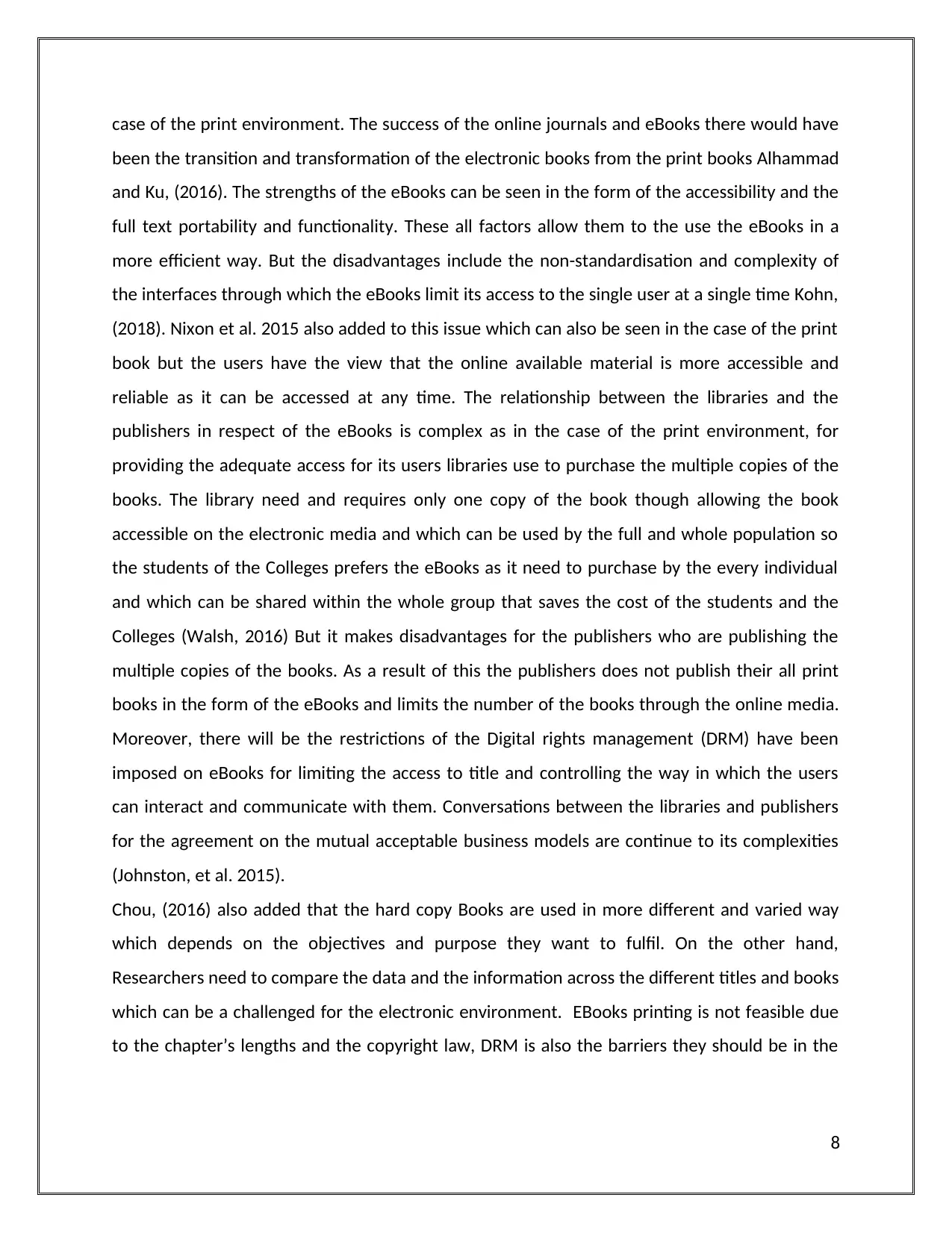
case of the print environment. The success of the online journals and eBooks there would have
been the transition and transformation of the electronic books from the print books Alhammad
and Ku, (2016). The strengths of the eBooks can be seen in the form of the accessibility and the
full text portability and functionality. These all factors allow them to the use the eBooks in a
more efficient way. But the disadvantages include the non-standardisation and complexity of
the interfaces through which the eBooks limit its access to the single user at a single time Kohn,
(2018). Nixon et al. 2015 also added to this issue which can also be seen in the case of the print
book but the users have the view that the online available material is more accessible and
reliable as it can be accessed at any time. The relationship between the libraries and the
publishers in respect of the eBooks is complex as in the case of the print environment, for
providing the adequate access for its users libraries use to purchase the multiple copies of the
books. The library need and requires only one copy of the book though allowing the book
accessible on the electronic media and which can be used by the full and whole population so
the students of the Colleges prefers the eBooks as it need to purchase by the every individual
and which can be shared within the whole group that saves the cost of the students and the
Colleges (Walsh, 2016) But it makes disadvantages for the publishers who are publishing the
multiple copies of the books. As a result of this the publishers does not publish their all print
books in the form of the eBooks and limits the number of the books through the online media.
Moreover, there will be the restrictions of the Digital rights management (DRM) have been
imposed on eBooks for limiting the access to title and controlling the way in which the users
can interact and communicate with them. Conversations between the libraries and publishers
for the agreement on the mutual acceptable business models are continue to its complexities
(Johnston, et al. 2015).
Chou, (2016) also added that the hard copy Books are used in more different and varied way
which depends on the objectives and purpose they want to fulfil. On the other hand,
Researchers need to compare the data and the information across the different titles and books
which can be a challenged for the electronic environment. EBooks printing is not feasible due
to the chapter’s lengths and the copyright law, DRM is also the barriers they should be in the
8
been the transition and transformation of the electronic books from the print books Alhammad
and Ku, (2016). The strengths of the eBooks can be seen in the form of the accessibility and the
full text portability and functionality. These all factors allow them to the use the eBooks in a
more efficient way. But the disadvantages include the non-standardisation and complexity of
the interfaces through which the eBooks limit its access to the single user at a single time Kohn,
(2018). Nixon et al. 2015 also added to this issue which can also be seen in the case of the print
book but the users have the view that the online available material is more accessible and
reliable as it can be accessed at any time. The relationship between the libraries and the
publishers in respect of the eBooks is complex as in the case of the print environment, for
providing the adequate access for its users libraries use to purchase the multiple copies of the
books. The library need and requires only one copy of the book though allowing the book
accessible on the electronic media and which can be used by the full and whole population so
the students of the Colleges prefers the eBooks as it need to purchase by the every individual
and which can be shared within the whole group that saves the cost of the students and the
Colleges (Walsh, 2016) But it makes disadvantages for the publishers who are publishing the
multiple copies of the books. As a result of this the publishers does not publish their all print
books in the form of the eBooks and limits the number of the books through the online media.
Moreover, there will be the restrictions of the Digital rights management (DRM) have been
imposed on eBooks for limiting the access to title and controlling the way in which the users
can interact and communicate with them. Conversations between the libraries and publishers
for the agreement on the mutual acceptable business models are continue to its complexities
(Johnston, et al. 2015).
Chou, (2016) also added that the hard copy Books are used in more different and varied way
which depends on the objectives and purpose they want to fulfil. On the other hand,
Researchers need to compare the data and the information across the different titles and books
which can be a challenged for the electronic environment. EBooks printing is not feasible due
to the chapter’s lengths and the copyright law, DRM is also the barriers they should be in the
8
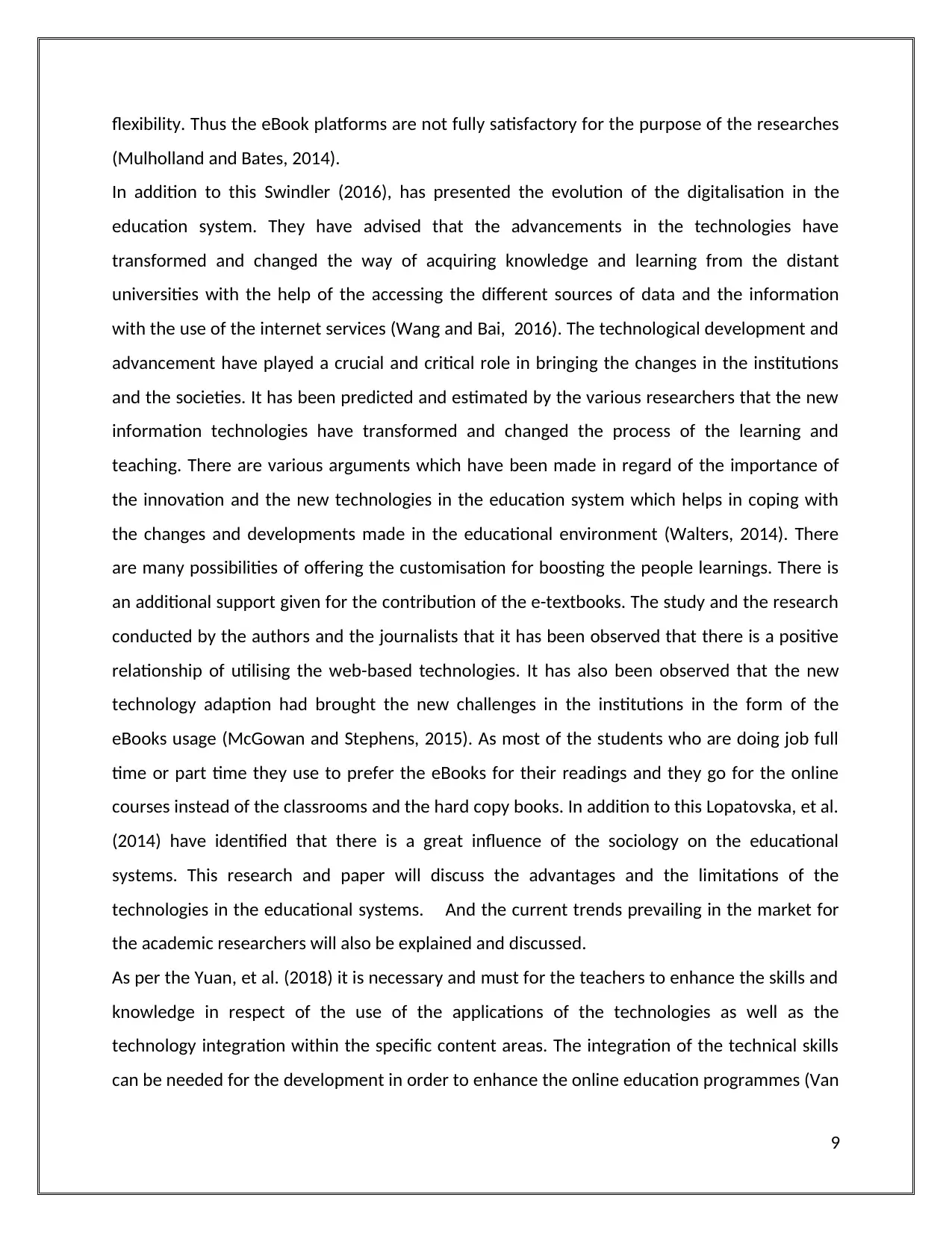
flexibility. Thus the eBook platforms are not fully satisfactory for the purpose of the researches
(Mulholland and Bates, 2014).
In addition to this Swindler (2016), has presented the evolution of the digitalisation in the
education system. They have advised that the advancements in the technologies have
transformed and changed the way of acquiring knowledge and learning from the distant
universities with the help of the accessing the different sources of data and the information
with the use of the internet services (Wang and Bai, 2016). The technological development and
advancement have played a crucial and critical role in bringing the changes in the institutions
and the societies. It has been predicted and estimated by the various researchers that the new
information technologies have transformed and changed the process of the learning and
teaching. There are various arguments which have been made in regard of the importance of
the innovation and the new technologies in the education system which helps in coping with
the changes and developments made in the educational environment (Walters, 2014). There
are many possibilities of offering the customisation for boosting the people learnings. There is
an additional support given for the contribution of the e-textbooks. The study and the research
conducted by the authors and the journalists that it has been observed that there is a positive
relationship of utilising the web-based technologies. It has also been observed that the new
technology adaption had brought the new challenges in the institutions in the form of the
eBooks usage (McGowan and Stephens, 2015). As most of the students who are doing job full
time or part time they use to prefer the eBooks for their readings and they go for the online
courses instead of the classrooms and the hard copy books. In addition to this Lopatovska, et al.
(2014) have identified that there is a great influence of the sociology on the educational
systems. This research and paper will discuss the advantages and the limitations of the
technologies in the educational systems. And the current trends prevailing in the market for
the academic researchers will also be explained and discussed.
As per the Yuan, et al. (2018) it is necessary and must for the teachers to enhance the skills and
knowledge in respect of the use of the applications of the technologies as well as the
technology integration within the specific content areas. The integration of the technical skills
can be needed for the development in order to enhance the online education programmes (Van
9
(Mulholland and Bates, 2014).
In addition to this Swindler (2016), has presented the evolution of the digitalisation in the
education system. They have advised that the advancements in the technologies have
transformed and changed the way of acquiring knowledge and learning from the distant
universities with the help of the accessing the different sources of data and the information
with the use of the internet services (Wang and Bai, 2016). The technological development and
advancement have played a crucial and critical role in bringing the changes in the institutions
and the societies. It has been predicted and estimated by the various researchers that the new
information technologies have transformed and changed the process of the learning and
teaching. There are various arguments which have been made in regard of the importance of
the innovation and the new technologies in the education system which helps in coping with
the changes and developments made in the educational environment (Walters, 2014). There
are many possibilities of offering the customisation for boosting the people learnings. There is
an additional support given for the contribution of the e-textbooks. The study and the research
conducted by the authors and the journalists that it has been observed that there is a positive
relationship of utilising the web-based technologies. It has also been observed that the new
technology adaption had brought the new challenges in the institutions in the form of the
eBooks usage (McGowan and Stephens, 2015). As most of the students who are doing job full
time or part time they use to prefer the eBooks for their readings and they go for the online
courses instead of the classrooms and the hard copy books. In addition to this Lopatovska, et al.
(2014) have identified that there is a great influence of the sociology on the educational
systems. This research and paper will discuss the advantages and the limitations of the
technologies in the educational systems. And the current trends prevailing in the market for
the academic researchers will also be explained and discussed.
As per the Yuan, et al. (2018) it is necessary and must for the teachers to enhance the skills and
knowledge in respect of the use of the applications of the technologies as well as the
technology integration within the specific content areas. The integration of the technical skills
can be needed for the development in order to enhance the online education programmes (Van
9
⊘ This is a preview!⊘
Do you want full access?
Subscribe today to unlock all pages.

Trusted by 1+ million students worldwide
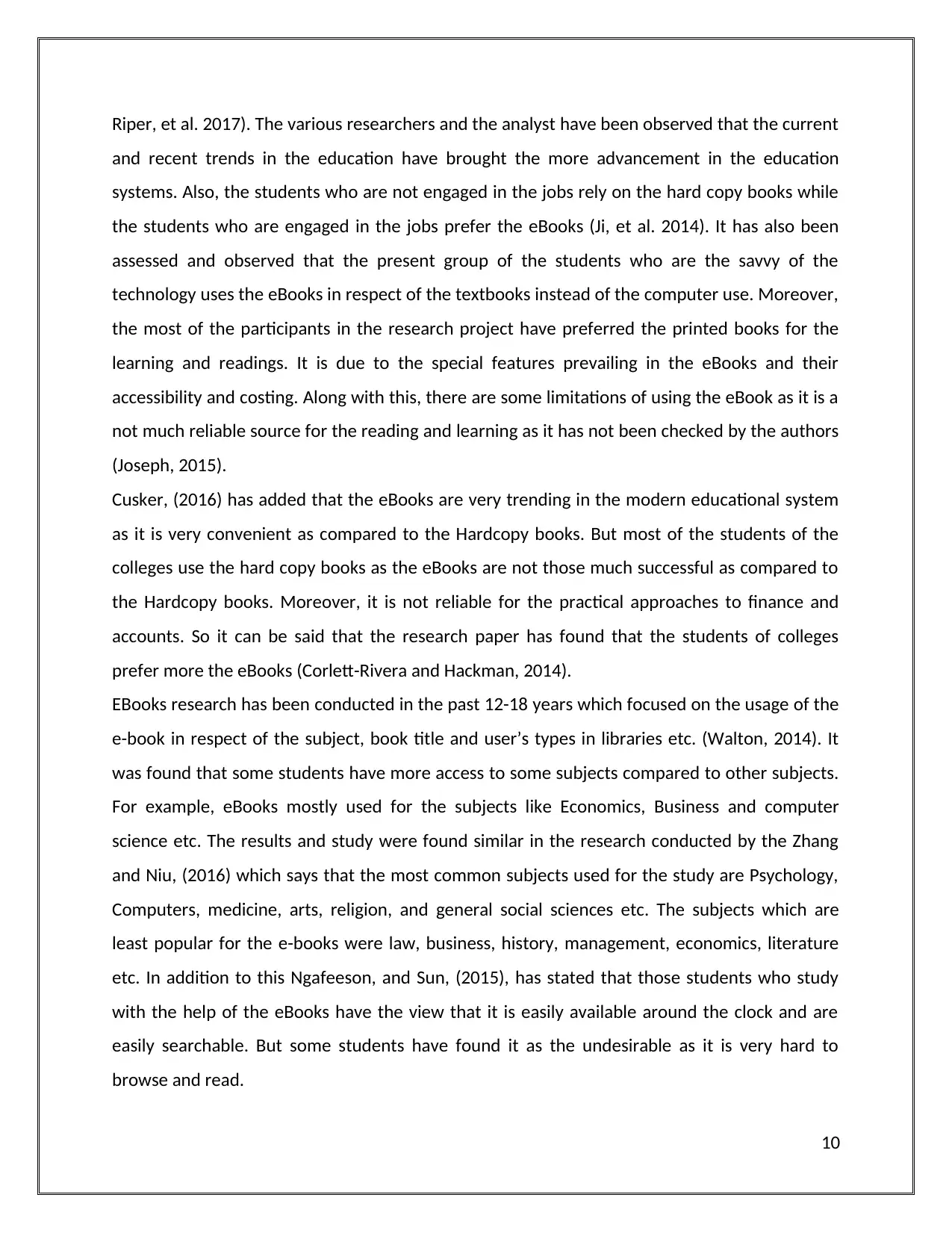
Riper, et al. 2017). The various researchers and the analyst have been observed that the current
and recent trends in the education have brought the more advancement in the education
systems. Also, the students who are not engaged in the jobs rely on the hard copy books while
the students who are engaged in the jobs prefer the eBooks (Ji, et al. 2014). It has also been
assessed and observed that the present group of the students who are the savvy of the
technology uses the eBooks in respect of the textbooks instead of the computer use. Moreover,
the most of the participants in the research project have preferred the printed books for the
learning and readings. It is due to the special features prevailing in the eBooks and their
accessibility and costing. Along with this, there are some limitations of using the eBook as it is a
not much reliable source for the reading and learning as it has not been checked by the authors
(Joseph, 2015).
Cusker, (2016) has added that the eBooks are very trending in the modern educational system
as it is very convenient as compared to the Hardcopy books. But most of the students of the
colleges use the hard copy books as the eBooks are not those much successful as compared to
the Hardcopy books. Moreover, it is not reliable for the practical approaches to finance and
accounts. So it can be said that the research paper has found that the students of colleges
prefer more the eBooks (Corlett-Rivera and Hackman, 2014).
EBooks research has been conducted in the past 12-18 years which focused on the usage of the
e-book in respect of the subject, book title and user’s types in libraries etc. (Walton, 2014). It
was found that some students have more access to some subjects compared to other subjects.
For example, eBooks mostly used for the subjects like Economics, Business and computer
science etc. The results and study were found similar in the research conducted by the Zhang
and Niu, (2016) which says that the most common subjects used for the study are Psychology,
Computers, medicine, arts, religion, and general social sciences etc. The subjects which are
least popular for the e-books were law, business, history, management, economics, literature
etc. In addition to this Ngafeeson, and Sun, (2015), has stated that those students who study
with the help of the eBooks have the view that it is easily available around the clock and are
easily searchable. But some students have found it as the undesirable as it is very hard to
browse and read.
10
and recent trends in the education have brought the more advancement in the education
systems. Also, the students who are not engaged in the jobs rely on the hard copy books while
the students who are engaged in the jobs prefer the eBooks (Ji, et al. 2014). It has also been
assessed and observed that the present group of the students who are the savvy of the
technology uses the eBooks in respect of the textbooks instead of the computer use. Moreover,
the most of the participants in the research project have preferred the printed books for the
learning and readings. It is due to the special features prevailing in the eBooks and their
accessibility and costing. Along with this, there are some limitations of using the eBook as it is a
not much reliable source for the reading and learning as it has not been checked by the authors
(Joseph, 2015).
Cusker, (2016) has added that the eBooks are very trending in the modern educational system
as it is very convenient as compared to the Hardcopy books. But most of the students of the
colleges use the hard copy books as the eBooks are not those much successful as compared to
the Hardcopy books. Moreover, it is not reliable for the practical approaches to finance and
accounts. So it can be said that the research paper has found that the students of colleges
prefer more the eBooks (Corlett-Rivera and Hackman, 2014).
EBooks research has been conducted in the past 12-18 years which focused on the usage of the
e-book in respect of the subject, book title and user’s types in libraries etc. (Walton, 2014). It
was found that some students have more access to some subjects compared to other subjects.
For example, eBooks mostly used for the subjects like Economics, Business and computer
science etc. The results and study were found similar in the research conducted by the Zhang
and Niu, (2016) which says that the most common subjects used for the study are Psychology,
Computers, medicine, arts, religion, and general social sciences etc. The subjects which are
least popular for the e-books were law, business, history, management, economics, literature
etc. In addition to this Ngafeeson, and Sun, (2015), has stated that those students who study
with the help of the eBooks have the view that it is easily available around the clock and are
easily searchable. But some students have found it as the undesirable as it is very hard to
browse and read.
10
Paraphrase This Document
Need a fresh take? Get an instant paraphrase of this document with our AI Paraphraser
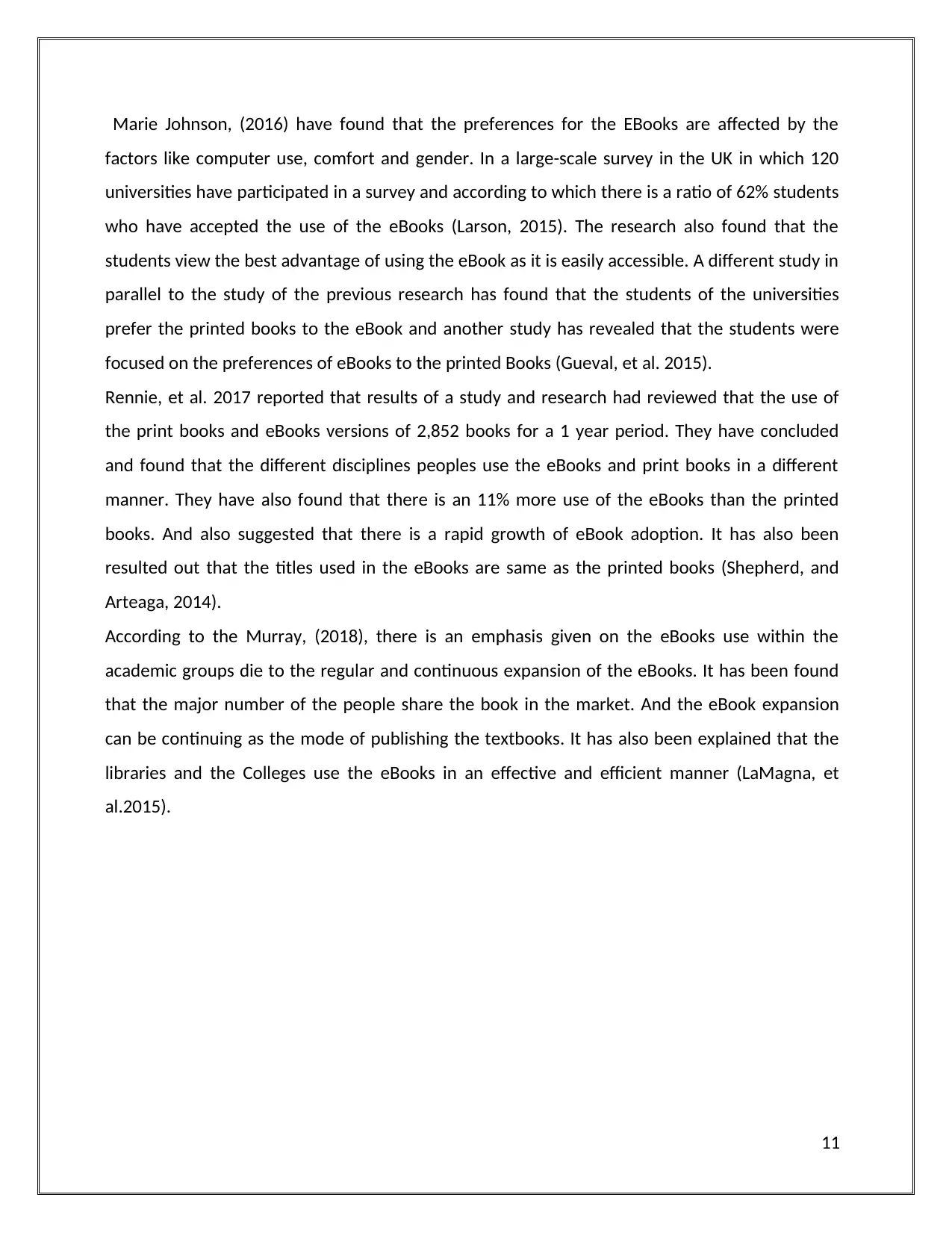
Marie Johnson, (2016) have found that the preferences for the EBooks are affected by the
factors like computer use, comfort and gender. In a large-scale survey in the UK in which 120
universities have participated in a survey and according to which there is a ratio of 62% students
who have accepted the use of the eBooks (Larson, 2015). The research also found that the
students view the best advantage of using the eBook as it is easily accessible. A different study in
parallel to the study of the previous research has found that the students of the universities
prefer the printed books to the eBook and another study has revealed that the students were
focused on the preferences of eBooks to the printed Books (Gueval, et al. 2015).
Rennie, et al. 2017 reported that results of a study and research had reviewed that the use of
the print books and eBooks versions of 2,852 books for a 1 year period. They have concluded
and found that the different disciplines peoples use the eBooks and print books in a different
manner. They have also found that there is an 11% more use of the eBooks than the printed
books. And also suggested that there is a rapid growth of eBook adoption. It has also been
resulted out that the titles used in the eBooks are same as the printed books (Shepherd, and
Arteaga, 2014).
According to the Murray, (2018), there is an emphasis given on the eBooks use within the
academic groups die to the regular and continuous expansion of the eBooks. It has been found
that the major number of the people share the book in the market. And the eBook expansion
can be continuing as the mode of publishing the textbooks. It has also been explained that the
libraries and the Colleges use the eBooks in an effective and efficient manner (LaMagna, et
al.2015).
11
factors like computer use, comfort and gender. In a large-scale survey in the UK in which 120
universities have participated in a survey and according to which there is a ratio of 62% students
who have accepted the use of the eBooks (Larson, 2015). The research also found that the
students view the best advantage of using the eBook as it is easily accessible. A different study in
parallel to the study of the previous research has found that the students of the universities
prefer the printed books to the eBook and another study has revealed that the students were
focused on the preferences of eBooks to the printed Books (Gueval, et al. 2015).
Rennie, et al. 2017 reported that results of a study and research had reviewed that the use of
the print books and eBooks versions of 2,852 books for a 1 year period. They have concluded
and found that the different disciplines peoples use the eBooks and print books in a different
manner. They have also found that there is an 11% more use of the eBooks than the printed
books. And also suggested that there is a rapid growth of eBook adoption. It has also been
resulted out that the titles used in the eBooks are same as the printed books (Shepherd, and
Arteaga, 2014).
According to the Murray, (2018), there is an emphasis given on the eBooks use within the
academic groups die to the regular and continuous expansion of the eBooks. It has been found
that the major number of the people share the book in the market. And the eBook expansion
can be continuing as the mode of publishing the textbooks. It has also been explained that the
libraries and the Colleges use the eBooks in an effective and efficient manner (LaMagna, et
al.2015).
11
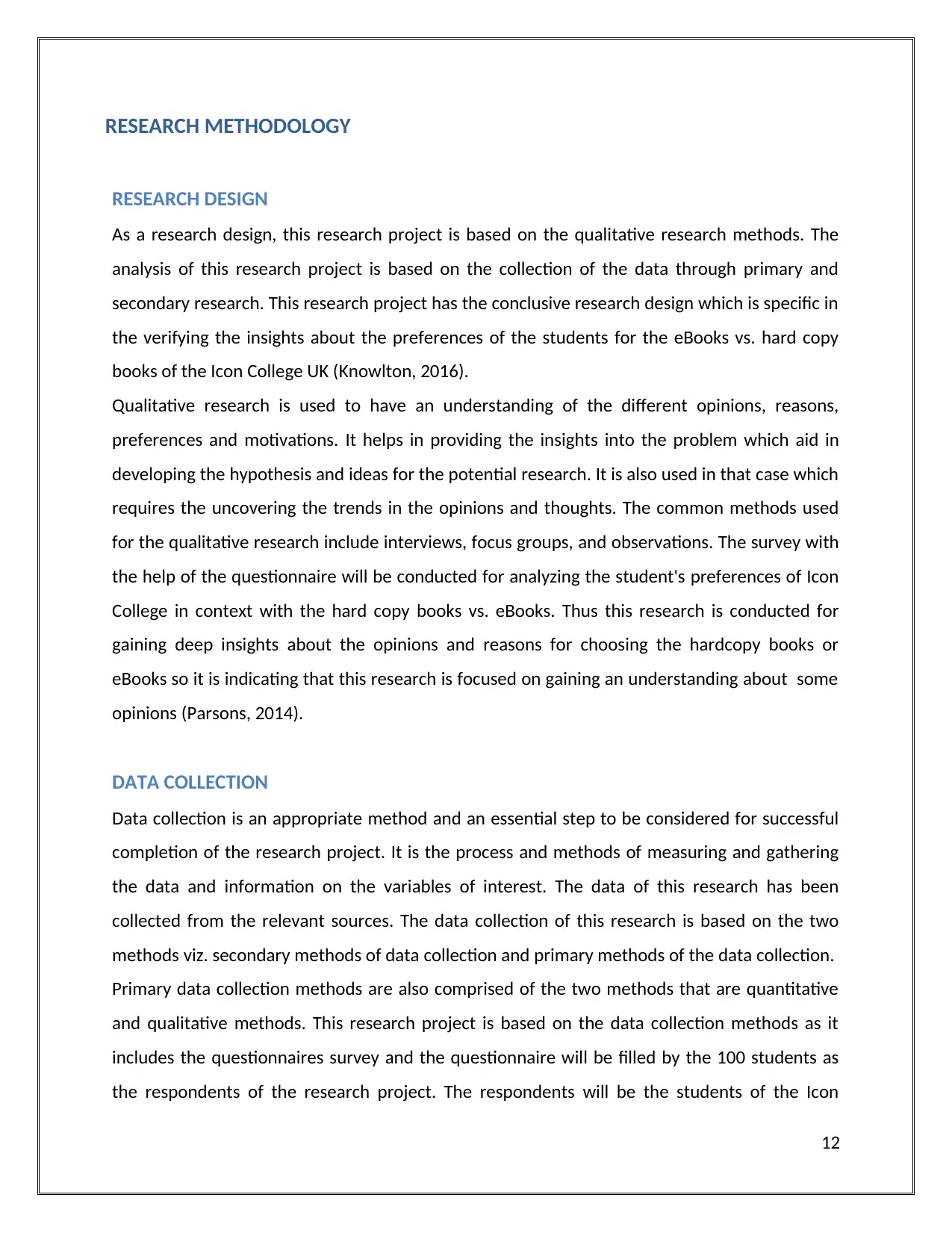
RESEARCH METHODOLOGY
RESEARCH DESIGN
As a research design, this research project is based on the qualitative research methods. The
analysis of this research project is based on the collection of the data through primary and
secondary research. This research project has the conclusive research design which is specific in
the verifying the insights about the preferences of the students for the eBooks vs. hard copy
books of the Icon College UK (Knowlton, 2016).
Qualitative research is used to have an understanding of the different opinions, reasons,
preferences and motivations. It helps in providing the insights into the problem which aid in
developing the hypothesis and ideas for the potential research. It is also used in that case which
requires the uncovering the trends in the opinions and thoughts. The common methods used
for the qualitative research include interviews, focus groups, and observations. The survey with
the help of the questionnaire will be conducted for analyzing the student's preferences of Icon
College in context with the hard copy books vs. eBooks. Thus this research is conducted for
gaining deep insights about the opinions and reasons for choosing the hardcopy books or
eBooks so it is indicating that this research is focused on gaining an understanding about some
opinions (Parsons, 2014).
DATA COLLECTION
Data collection is an appropriate method and an essential step to be considered for successful
completion of the research project. It is the process and methods of measuring and gathering
the data and information on the variables of interest. The data of this research has been
collected from the relevant sources. The data collection of this research is based on the two
methods viz. secondary methods of data collection and primary methods of the data collection.
Primary data collection methods are also comprised of the two methods that are quantitative
and qualitative methods. This research project is based on the data collection methods as it
includes the questionnaires survey and the questionnaire will be filled by the 100 students as
the respondents of the research project. The respondents will be the students of the Icon
12
RESEARCH DESIGN
As a research design, this research project is based on the qualitative research methods. The
analysis of this research project is based on the collection of the data through primary and
secondary research. This research project has the conclusive research design which is specific in
the verifying the insights about the preferences of the students for the eBooks vs. hard copy
books of the Icon College UK (Knowlton, 2016).
Qualitative research is used to have an understanding of the different opinions, reasons,
preferences and motivations. It helps in providing the insights into the problem which aid in
developing the hypothesis and ideas for the potential research. It is also used in that case which
requires the uncovering the trends in the opinions and thoughts. The common methods used
for the qualitative research include interviews, focus groups, and observations. The survey with
the help of the questionnaire will be conducted for analyzing the student's preferences of Icon
College in context with the hard copy books vs. eBooks. Thus this research is conducted for
gaining deep insights about the opinions and reasons for choosing the hardcopy books or
eBooks so it is indicating that this research is focused on gaining an understanding about some
opinions (Parsons, 2014).
DATA COLLECTION
Data collection is an appropriate method and an essential step to be considered for successful
completion of the research project. It is the process and methods of measuring and gathering
the data and information on the variables of interest. The data of this research has been
collected from the relevant sources. The data collection of this research is based on the two
methods viz. secondary methods of data collection and primary methods of the data collection.
Primary data collection methods are also comprised of the two methods that are quantitative
and qualitative methods. This research project is based on the data collection methods as it
includes the questionnaires survey and the questionnaire will be filled by the 100 students as
the respondents of the research project. The respondents will be the students of the Icon
12
⊘ This is a preview!⊘
Do you want full access?
Subscribe today to unlock all pages.

Trusted by 1+ million students worldwide
1 out of 41
Related Documents
Your All-in-One AI-Powered Toolkit for Academic Success.
+13062052269
info@desklib.com
Available 24*7 on WhatsApp / Email
![[object Object]](/_next/static/media/star-bottom.7253800d.svg)
Unlock your academic potential
Copyright © 2020–2025 A2Z Services. All Rights Reserved. Developed and managed by ZUCOL.





